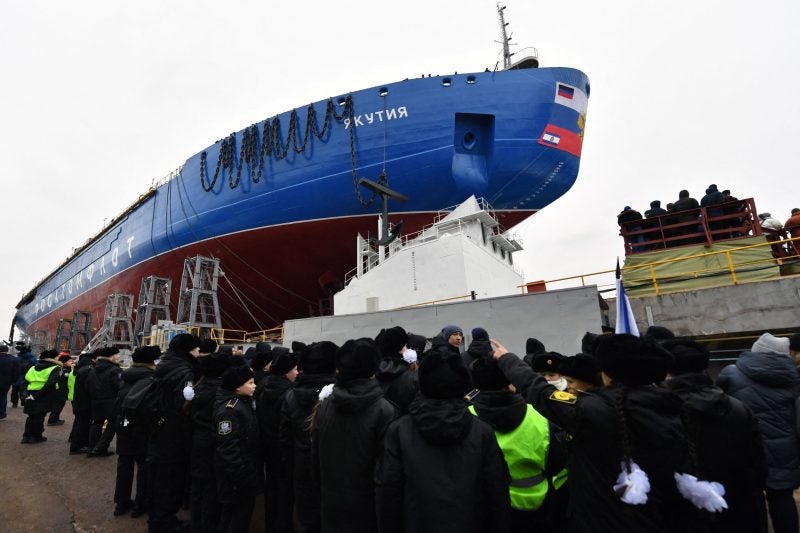
With the knowledge that within 15-20 years climate change will make for open waters in the Arctic Sea during the summer months, the UK Royal Navy should harden the hulls of its ships in order to remain competitive with peers and rivals in the disruptive ice flows of the High North, according to a senior former UK military official.
Speaking before the UK Parliament’s Defence Committee on 22 November, Lt Gen Richard Nugee (retired), former climate change and sustainability strategy lead at the Finance and Military Capability within the Ministry of Defence (MoD), said that dedicated ice-breaking ships would not be needed throughout the year in the region.
“I would argue that between the frozen sea in the winter and the open water in the summer there is a period of time when the ice is not thick enough that it needs an ice-breaker but is too thick for the very thin hulls of our warships,” said Nugee.
Nugee, now holding non-executive director position at private company Remit Zero and the MoD’s Defence Science Expert Committee, told the Defence and Climate Change hearing that he was aware Russia, China and Canada were already hardening hulls in preparation for traversing disruptive ice-flows, and gave his view that the UK should be capable of deploying vessels as early and as late in the calendar year as potential adversaries.
“I think we should be doing the same,” continued Nugee, ”not of course the whole fleet—we do not need that—but enough of our fleet so that if we were required by our Government to have a presence during that period of the year, we would have the capability to do so and to not cede that to the Russians, for example, who will have that capability.”
Ice-strengthening the fleet
Retrospectively hardening the hulls of the British fleet is a difficult prospect. Distinct from ice-breakers, ice-strengthened ships can have a double hull with a pocket of air or water ballast, a thickened sea-level rim where the ice floats, and reinforcements around the bow and forward areas of the ship.
If possible, these renovations would come into conflict with one of the principal strengths of the UK naval services as a global anti-submarine navy. Designed for stealth and to hunt submarines, Royal Navy ships feature sonar domes mounted on the bow. Contact with disruptive ice-flows would cause significant damage to the glass fibre they are constructed with to allow sound to permeate through.
On the same day that Nugee was giving evidence to the Defence Select Committee, Russia raised the flag on the first of two new nuclear-powered ice-breaker ships. These are the third and fourth LK-60 class ships, the most powerful ice-breakers currently employed anywhere in the world, and construction is already underway on another three of these vessels that Russia intends to build.
The commissioning of the ships better serves the new dynamic of hydrocarbon production under sanction in Russia, with oil and gas exports now heading east to Asian markets and taking advantage of trade routes through the Arctic sea.
In 2018, a Defence Select Committee publication, ‘On Thin Ice: UK Defence in the Arctic’, set out Parliament’s view that the UK and its allies should be ‘extremely wary’ of Russia’s intentions in the high North, finding it difficult to credit Russia’s military deployment in the Arctic as solely for defensive purposes.
Commitments to the High North
While Nugee’s oral evidence may trouble observers concerned that the Arctic should not become a de facto internal sea for Russia, the UK is part of a union of recognised alliances, including Norway – a NATO ally and member of the UK-led Joint Expeditionary Force – that possess significant ice capabilities appropriate to a nation with home waters in the High North.
The Royal Navy has demonstrated willingness to operate in the High North in recent times. In November the survey ship HMS Enterprise ventured closer to the North Pole than any other Royal Navy vessel in 2022, updating charts to maintain the freedom of navigation in the High North. In April the aircraft carrier HMS Prince of Wales and Type 23 frigate HMS Richmond entered the High North as part of Exercise Northern Viking and proved that US Air Force F-22 jets could operate in the Arctic Circle.
“We always keep the future capabilities of our ships under constant review.”
While visiting Norway In April of this year, UK Defence Secretary Ben Wallace set out a new Arctic strategy building on interoperability with Arctic allies by investing in a new generation of Anti-Submarine Warfare frigates. ‘The UK’s Defence Contribution in the High North’ also highlights the continuing UK capability to operate under the arctic ice.
The MoD were asked for comment on the proposition of ice-strengthening Royal Navy ships for the High North. A Royal Navy spokesperson replied: “The Royal Navy maintains a balanced fleet – including the Ice Patrol Ship, HMS Protector – and continues to operate in the High North to maintain the security of our nation. We always keep the future capabilities of our ships under constant review.”
HMS Protector is the Royal Navy’s only ice patrol ship, deployed 330 days a year, with a focus on the waters of Antarctica and the Southern Hemisphere.





